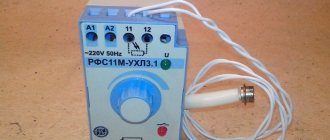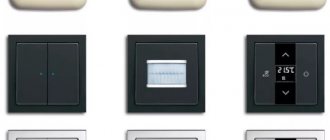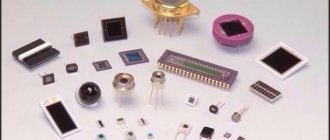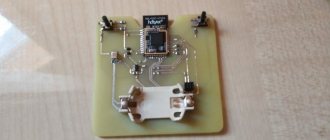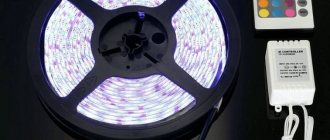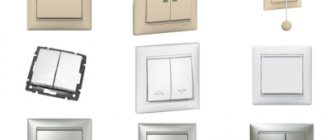Installing a lighting system in a building requires considerable financial and labor costs. At the same time, open cable routing worsens the appearance of the interior, while at the same time, to install hidden wiring, it is necessary to form grooves in the walls and drill sockets for the component elements. Particular difficulties arise if it is necessary to install additional lamps after completing renovations in a room. The best solution to this problem is to purchase a modern wireless switch. It allows you to remotely control the light, adjust its brightness, and set a delay for the operation of electric lamps.
Wireless switch - a device designed for remote control of lighting Source werkel-kupit.ru
Varieties
Modern wireless light switches are classified according to the following criteria:
- Number of controllable luminaires. There are wireless devices designed for one or more groups of lighting fixtures with different numbers of bulbs.
- Possibility of adjusting the luminous flux. The brightness of the lighting is adjusted by long pressing the button of the mechanism with a built-in dimmer.
- Management method. In stores there are designs with convenient touch or push-button switches and remote controls.
Using auxiliary functions allows you to configure the delay of command execution for some time. Then, before the lights go out in the room, the user can perform a number of necessary actions.
With remote control
Simultaneously with stationary switches, remote control of individual, multiple lamps is carried out from an ordinary key fob or remote control. At the same time, 2 buttons are allocated to each channel of the latter: one turns on the electrical power and increases the brightness of the light, the second reduces the light intensity and turns off electrical appliances.
Switching the load on and off is done by briefly pressing the button, and adjusting the light flux is done by holding it down for more than one second. The factory kit usually contains parts for wall mounting.
The presence of a remote control allows you to control the lighting in the house without going to the switches, without pressing them Source elektrikexpert.ru
Touchpad
It is a screen made of crystal glass. It has an image with a visualized backlight. Typically, switching is carried out by briefly applying a finger, lighting control is carried out by holding the latter on the marked area of the panel.
Subsequently, when a person touches the surface of the device, the parameters of the capacitor in the electric field change and a control signal is produced. It triggers the switching circuit of the switch. The absence of mechanical elements in such a design increases the reserve of its functioning to one hundred thousand inclusions.
The touch panel of the wireless switch is activated after lightly touching its surface Source ixbt.online
Multi-channel radio switch
Up to eight channels can be configured, all of them connected to one lighting system. Such a device makes it possible to regulate the light in all rooms of the building. It remembers the addresses of specific remote controls and executes commands only at the individual bitrate.
This design transmits and receives information at a specific speed (measured in kbit/s), and the signal frequency (about 35 kHz) does not change at all. The basis of any remote control is a pulse generator. Its notification is modulated by a specific indication code.
The range of the wireless radio switch is up to 250 meters, the battery charge is designed for 5-7 years of active operation Source bt-energy.ru
Advantages and disadvantages
As practice shows, a wireless light switch is an extremely convenient design. Among its main advantages it is worth noting:
- simple installation that does not involve disturbing the finishing of the walls, chipping their surface, or laying additional wiring;
- the ability to control all lighting fixtures in the home using one control panel;
- large signal reception radius: 30-250 m, which depends on the product model, layout, load of furniture in the room;
- safety for residents: the device operates at a minimum current and in any case is not capable of harming human health.
The disadvantages of wireless devices include loss of control of the lighting system when the battery in the remote control is discharged or the Internet is disconnected (if WI-FI is used).
Wireless switches have no physical connection to switching units at all Source i.siteapi.org
Design and principle of operation of a wireless switch
A wireless remote switch (WRS) consists of a transmitter that converts the control signal into a radio signal from a master oscillator. This happens after pressing the switch key, touching the touchpad, or sending a signal from the phone via WI-FI. In the transmitter's coverage area there is a receiver (actuator) that “closes ↔ opens” the contacts of the power relay connected to the power circuit break at the moment the radio signal is received. In addition to the radio frequency of 315 MHz or 433.92 MHz, infrared waves are also used for signal transmission.
Application
It is advisable to purchase and then install wireless switches (instead of traditional devices), if necessary:
- Turning lights on or off at great distances. Installation of wiring is expensive, the radio switch (depending on the product) operates within a range of no more than 350 meters.
- Transferring any device. In order not to move bulky furniture and to avoid damaging the finish, the device can be installed on the wall, inside the cabinet.
- Elimination of installation defects. When moving the power line, there is no need to trench the walls; it will be enough to connect the mechanism with or without a remote control.
- Ensuring convenient use of electrical appliances. The contactless switch does not take up much space and is easy to operate.
- Control lighting throughout the house. A small functional device with a remote control provides the ability to control connected light sources from several zones.
- Saving the design idea. If the switch cannot be installed inside a niche, the wireless device will fit perfectly into any interior style.
Important! In wooden buildings, when flammable building materials are used inside the buildings, the laid cable significantly increases the likelihood of a fire. The use of distance structures will be the most economical and simple solution.
Modern wireless switches have a stylish appearance and can be installed within a few minutes Source elektrikexpert.ru
What to consider before purchasing?
You should purchase a wireless module in a specialized store, taking into account such product characteristics as:
- type of light bulbs available for control;
- dimensions and general appearance of the product (material from which the case is made, color scheme, shape and number of keys);
- operating voltage range;
- number of channels;
- signal coverage radius;
- maximum permissible load during operation;
- rated current level;
- factory equipment;
- list of operating frequencies;
- method of transmitting a command signal;
- encoding (presence or absence);
- type of power supply for the transmitter (generator, battery);
- the period declared by the manufacturer for which the battery capacity is sufficient;
- principle of mounting the device;
- price.
Additionally, you need to find out from the seller what warranty period the manufacturer provides for the product and where the service centers are located. Complete information will help you make the right choice and purchase exactly the model that will satisfy the buyer’s requirements for the device in all respects.
What to look for during the selection process
Before you begin selecting a wireless switch, you should determine the number of lamp groups that the device will serve. The number of channels can vary from one to eight. Low power consumption of touch and button products in gentle standby mode guarantees long-term operation of the transmitter: battery replacement is not required for two to seven years.
Additionally, it is necessary to calculate the total power of the light sources planned for connection, then accordingly select a device with optimal technical characteristics. It is definitely worth considering that models using infrared rays operate only at a viewing distance of the receiver; at the same time, radio waves can bend around all sorts of obstacles and penetrate walls inside structures. For a private home, there is no need to purchase a transmitter with a maximum power of 10 mW and a range of 0.1 km. In this case, a distance of 30 meters will be sufficient.
What does the market offer?
A wide range of wireless remote switches allows you to choose a product based on price, characteristics and appearance.
Below we consider just a few models that the market offers:
- Fenon TM-75 is a remote-controlled switch made of plastic and designed for a voltage of 220 V. The features of the device include the presence of two channels, a 30-meter range, the presence of a remote control and a delay switch function.
A group of lighting fixtures can be connected to each channel and controlled. The Fenon TM-75 wireless switch can be used with chandeliers, spotlights, LED and track lights, as well as other devices operating on 220 Volts. - Inted 220V is a wireless radio switch designed for wall mounting. It has one key and is installed in conjunction with the receiving unit. The operating voltage of the product is 220 Volts, and the range is 10-50 meters. The wireless light switch is attached using self-tapping screws or double-sided tape. The body is made of plastic.
- INTED-1-CH is a light switch with remote control. With this model you can control light sources remotely. The power of the lamps can be up to 900 W, and the operating voltage of the product is 220 V. Using a radio switch, you can control the equipment, turn on and off the lights or alarms. The product is based on a receiver and transmitter. The latter has the form of a key fob, which is small in size and transmits a signal over a distance of up to 100 m. The product body is not protected from moisture, so additional protection must be provided when installing outdoors.
- Wireless touch switch controlled via remote control. The product is mounted on the wall, has small dimensions and is made of tempered glass and PVC. The operating voltage is from 110 to 220V, and the rated power is up to 300 W. The package includes a switch, remote control and bolts for attaching the accessory. The average life cycle is 1000 clicks.
- Inted 220V 2 Receiver - Wireless Light Switch for Wall Mounting. Control is carried out using two keys. The body is made of plastic. The operating voltage is 220 V. The number of independent channels is 2.
- BAS-IP SH-74 is a wireless radio switch with two independent channels. Control is carried out using a mobile phone on the Android operating system. To work, you must install the BAS application. The SH-74 model is used to control incandescent lamps with a power of up to 500 W, as well as fluorescent light bulbs (power limit - 200 W).
- Feron TM72 is a wireless switch that controls lighting at a distance of up to 30 meters. The light sources are combined into a receiving unit, and switching on and off is done using the remote control. The TM72 model has two channels, each of which can be connected to a specific group of devices. The product has a large power reserve per channel (up to 1 kW), which allows you to connect different types of light sources. The big advantage of the model is the presence of a delay ranging from 10 to 60 seconds.
- Wireless 3-channel switch 220V Smartbuy is designed for connecting light sources into three channels with a power limit of up to 280 W. The rated supply voltage is 220 V. Control is carried out from the remote control, which has a range of 30 meters.
- Z-Wave CH-408 is a wall-type radio switch that allows you to program various scenarios for controlling lighting devices. If necessary, up to eight switches can be connected to it. Among the additional features, it is worth highlighting the management of Z-Wave devices (up to 80) and ease of configuration regardless of the main controller. The device is powered by two batteries, and when they are low, a corresponding signal is given. Firmware updates are performed via the Z-Wave network. The maximum distance to the controller should not exceed 75 meters. Protection class - IP-30.
- Feron TM-76 is a wireless light switch that is controlled remotely using a radio signal. The receiver connects to light sources, and the remote control controls the receiving unit at a distance of up to 30 meters. The Feron TM-76 model has three independent channels, each of which can be connected to its own group of lighting fixtures. In this case, control will be carried out separately, using the remote control. The maximum power reserve is up to 1 kW, which allows you to connect various types of lamps (including incandescent). The operating voltage is 220 V.
How to connect with your own hands
Typically, the dimensions of the receiving module do not exceed the size of a box of matches. Therefore, it is easy to place it in the installation box or other easily accessible places near the installation wires. It can also be mounted at the location of the old switch (the latter must be removed).
To correctly install a wireless switch, you need to use a simple connection diagram Source strojdvor.ru
According to safety precautions, the day before connecting a wireless device, it is extremely important to turn off the electricity at the distribution panel. Connect the device to the electrical circuit in the following sequence:
- Cut the phase wire suitable for the lamp, connect the ends to Lin and Lout (in the case of a single-channel product).
- In a multi-channel model, separate the phase, then connect it to the corresponding light bulbs through the output terminals L1out, L2out, ..., Lnout.
- The common zero N is applied to the lamp lamps through the output and input zero terminals.
The contactless switch can be attached using the following methods:
- For screws into the socket of an old device or into a newly created hole.
- Glue using double-sided tape (usually included in the kit) to facing tiles, wallpaper or any parts in the interior.
The installation process of a wireless switch is practically no different from the installation of a conventional switch, the only difference is that there is no need for wiring Source electrikmaster.ru
